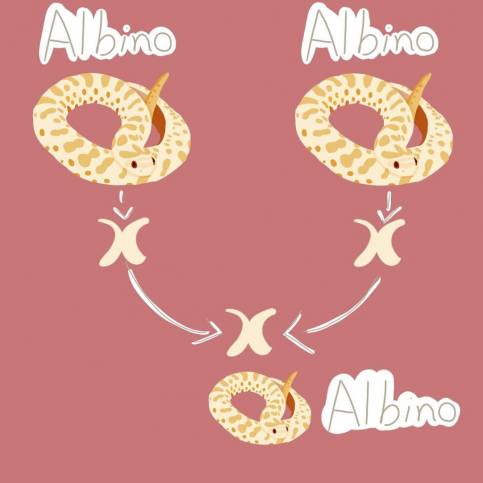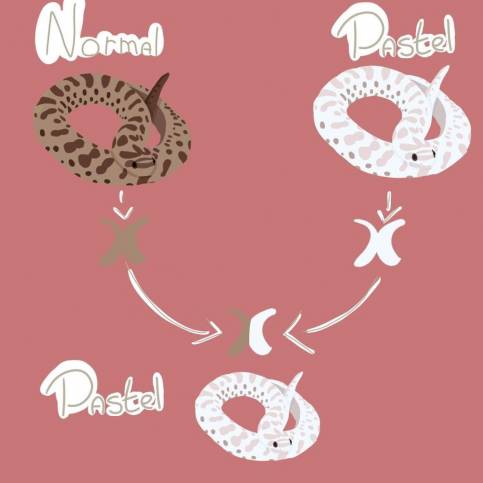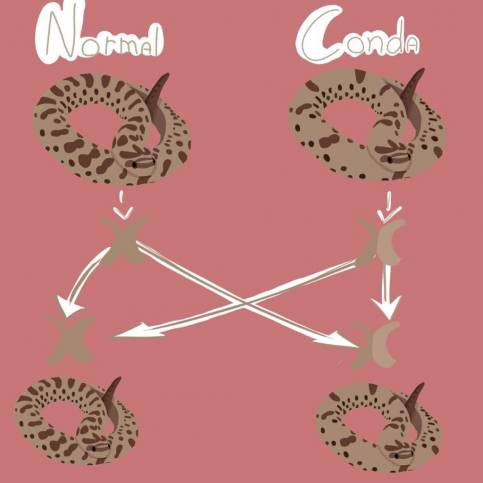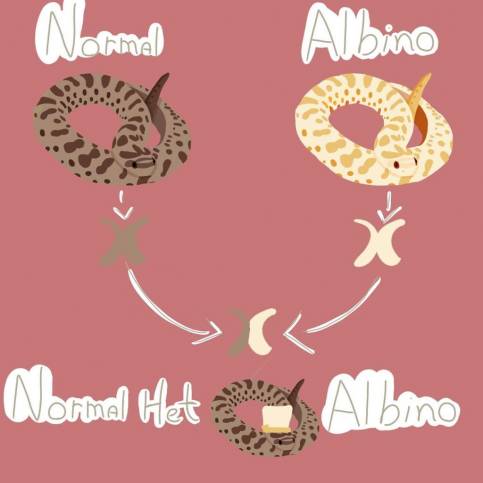In every genetic trace whether it's the color, the pattern is determined by a set of alleles in the chromosome. When an animal reproduces it will split one of the alleles to its offspring and so will do the other parent, so the baby will have two alleles.
If both alleles are normal, you will get a snake with the wild type coloration and pattern. When one of these become mutated you may or may not get a visual difference in the animal itself.
These mutations can have different characteristics and classifications:
- Recessive:
-> RECESSIVE TRAIT + SAME RECESSIVE TRAIT = SNAKE WITH SAME MUTATION
-> Ex: ALBINO SNAKE + ALBINO SNAKE = ALBINO
-> RECESSIVE TRAIT + DIFFERENT TRAIT = SNAKE HET RECESSIVE TRAIT
-> Ex: ALBINO SNAKE + NORMAL SNAKE = HET ALBINO SNAKE
When a trait is recessive, both alleles must be mutated in the same way in order to make difference in the animal, so you need to breed two snakes with the same recessive trait in order to get new snakes with the same mutation. If you breed a snake with a recessive mutation with a normal or with one with another mutation, the offspring will be a het for the recessive trait.
- Dominant:
-> DOMINANT TRAIT + NORMAL/MUTATED TRAIT = SNAKE WITH DOMINANT TRAIT
-> PASTEL SNAKE + NORMAL/MUTATED SNAKE = PASTEL
When a trait is dominant this trait will define the visual appearance of the offspring even if the other allele is still normal. (For the dominant trait to be passed for sure, one of the parents need to have both alleles of this same trait.)
- Co-Dominant:
-> CO-DOMINANT TRAIT + SAME CO- DOMINANT TRAIT = SUPER FOR TRAIT/ SAME MORPH/ NORMAL
- 2 mutated alleles = super for trait
- mutated for co-dominant trait + normal allele = morph
- normal + normal allele = normal
-> ANACONDA MORPH + ANACONDA MORPH = SUPER CONDA MORPH/CONDA MORPH/NORMAL
- 2 conda alleles = superconda
- Conda + normal allele = conda
- normal + normal allele = normal
If you have a snake with both alleles mutated for the co-dominant trait this trait will be more present (ex: if you have a snake with both alleles mutated for conda morph - mutation -, the snake will be a super conda and will have no pattern ). But, the co-dominant traits are a little harder to predict, that's because if you breed two snakes with the same co-dominant trait, there are three different things that can happen: one of the parents will split off one mutated (ex: conda) allele and the other a normal, so the snake will be the same morph as the parents (ex: the conda morph).
Another thing that can happen is that both snakes will split off one mutated allele each, if this happens the snake will be a super for the morph. Or, each snake will split off one normal allele, so the young will look normal and will be a het for the trait.
Since all these genetic information are pretty confusing, we made some drawings and here they are:
Parceria:

Com supervisão de Nicole Almeida, jornalista do Grupo Meon.














Os comentários e avaliações são de responsabilidade exclusiva de seus autores e não representam a opinião do site.